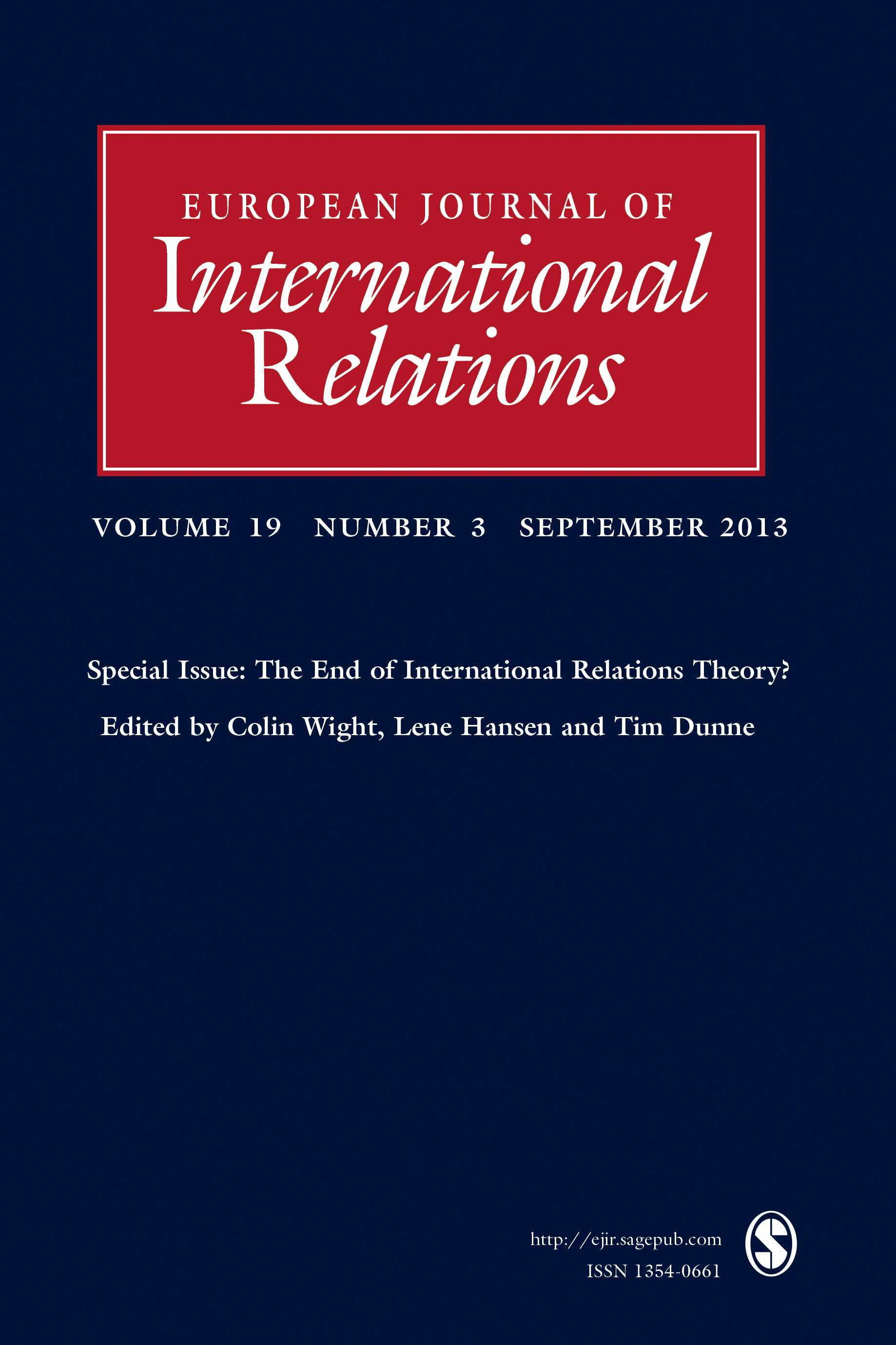 Editor’s Note: This is a guest post by Andrew Bennett. It is the fifth installment in our “End of IR Theory” companion symposium for the special issue of the European Journal of International Relations. SAGE has temporarily ungated all of the articles in that issue. This post refers to Bennett’s article (PDF). A response, authored by Stacie E. Goddard, will appear at 10am Eastern.
Editor’s Note: This is a guest post by Andrew Bennett. It is the fifth installment in our “End of IR Theory” companion symposium for the special issue of the European Journal of International Relations. SAGE has temporarily ungated all of the articles in that issue. This post refers to Bennett’s article (PDF). A response, authored by Stacie E. Goddard, will appear at 10am Eastern.
Other entries in the symposium–when available–may be reached via the “EJIR Special Issue Symposium” tag.
As the internet lends itself to a rather different tone from that of referred journals, I adopt the pose of a curmudgeon. I want to pick a few fights, starting with epistemology and then moving through methodology to pedagogy.
In the tradition of schismatics, I argue most fiercely in my EJIR article against those with whom I agree on many things, but with whom I differ in subtle but important ways on the future of IR theory. First, regarding inter-paradigm debates in IR, I agree fully with the critiques Patrick Thaddeus Jackson, Dan Nexon, and David Lake make in the special issue regarding the need to move beyond paradigmatic “isms” (realism, neoliberal institutionalism, constructivism, feminism, etc.) as the focus of IR theory. Yet I disagree with Jackson’s and Nexon’s assertion that researchers using statistical methods necessarily adopt Humean notions of causation, and I argue that statistical analysis and many other methods have roles to play in developing and testing IR theories. Contra Lake, I argue that there are better ways to structure the study of IR than his proposed framework of interests, interactions, and institutions, which gives insufficient to the social mechanisms that constructivists and interpretivists emphasize.
Second, I concur with key post-positivist arguments: observation is theory laden, knowledge claims are always part of mechanisms of power, meaning is always social, and agents and social structures are mutually constitutive. Yet I argue that IR should continue to aspire to predictive theories, that there are defensible standards for judging some explanations and interpretations to be better than others, and that theories about causal mechanisms are compatible with many interpretivist approaches to IR. In my reading of their essays, none of the interpretivist-minded scholars writing in the special issue explicitly object to my positions on these issues, but other IR scholars do reject claims like the ones I make.
Third, I argue that statistical, formal, experimental, qualitative case study, narrative, and many other methods are useful in developing and testing theories about causal mechanisms. Yet (spoiler alert) I reject the view that there is one logic of inference in IR and that this logic is “explicated and formalized clearly in discussions of quantitative research methods.”
Regarding pedagogy, while I fully embrace Rudra Sil and Peter Katzenstein’s critique of paradigmatism, which is similar to the critiques Jackson, Nexon, and Lake make in the special issue of EJIR, I argue that “analytic eclecticism,” Sil’s and Katzenstein’s preferred term, is an awkward rallying cry. “Eclecticism,” following dictionary definitions, can mean borrowing from the best of different traditions, as these authors clearly intend, but it can also mean “indiscriminate.” I offer instead the term “structured pluralism” (not catchy, I know, but it conveys the vision for IR theorizing that I have in mind).
Here is my argument in a nutshell: IR theorizing has to move from a focus on grand paradigmatic “isms” toward theories about causal mechanisms and middle range theories (or in my term typological theories) about recurrent combinations of theorized mechanisms in specified populations or contexts. But IR scholars are understandably reluctant to move beyond the isms until it is clear that theories about causal mechanisms can still allow for a structured field-wide discourse among scholars, clear pedagogy for students, and cumulative and policy-relevant research findings.
My EJIR essay thus sketches out four moves essential to this transition. First, it clarifies the philosophical and definitional issues associated with theories on causal mechanisms. Second, it acknowledges the importance of post-positivist critiques of IR theory, but it argues that many interpretivist approaches are compatible with theorizing about causal mechanisms. Third, it briefly outlines the contributions that diverse methods can make to the study of causal mechanisms. Finally – and I think this is the most important and novel move — I outline a “Taxonomy of Theories about Causal Mechanisms” as a framework for cumulative theoretical progress, field-wide discourse, and communication with political actors and other fields of study within and beyond political science.
For present purposes I will yada-yada-yada the first three moves (Kuhn, Lakatos, novel facts, scientific realism, and all that; just read the article) and concentrate on the last. To provide a framework that is simple enough for field-wide discourse and cumulative theorizing, but complex enough to accommodate theories about many different kinds of causal mechanisms, I propose a taxonomy along two dimensions. The first includes theories about mechanisms rooted in material power (the focus of realism), institutional efficiency (neoliberalism’s central idea), and normative legitimacy (a central constructivist concept). This builds a bridge to the three most prominent isms without reifying them into paradigms. The second dimension of the taxonomy encompasses the four possible kinds of mechanisms through which agents and structures interact: agent to agent, structure to agent, agent to structure, and structure to structure (including both material and normative or ideational structures; one could add a fifth category of intra-agent cognitive and physiological mechanisms).
The resulting twelve types of theories about mechanisms capture a fair amount of IR theorizing (see the table in the paper, which also includes examples, levels of analysis, and related fields of study). I argue that this taxonomy serves six purposes:
- it provides a checklist for ensuring that important potential alternative explanations of a phenomenon have not been omitted from research projects;
- researchers can develop increasingly comprehensive historical explanations of particular cases drawing on theories from any of the categories in the taxonomy;
- scholars can drill down deeper into any one of the boxes in the taxonomy, refining or creating theories on the mechanisms in that category, or disaggregating theorized mechanisms into different sub-types;
- using statistical methods, researchers can develop estimates of the magnitude of the causal effects, in specified contexts or issue areas, of the variables identified in each of the theories about how causal mechanisms work;
- researchers can refine the scope conditions of the theories in any of the categories and specify more clearly the contexts and populations to which they apply; and
- scholars can use the taxonomy to develop middle-range or typological theories about how combinations of mechanisms interact in shaping outcomes for specified cases or populations.
In short, IR theory can move beyond paradigmatism by creating a theoretical discourse centered on theories on causal mechanisms that is epistemologically, theoretically, and methodologically pluralistic but at the same time structured and cumulative. This discourse can re-energize not only dialogues within IR, but conversations with scholars in comparative and American politics, economics, psychology, sociology, and history, all of whom are more conversant in the language of causal mechanisms than the ingrown language of IR’s isms.
Daniel H. Nexon is a Professor at Georgetown University, with a joint appointment in the Department of Government and the School of Foreign Service. His academic work focuses on international-relations theory, power politics, empires and hegemony, and international order. He has also written on the relationship between popular culture and world politics.
He has held fellowships at Stanford University's Center for International Security and Cooperation and at the Ohio State University's Mershon Center for International Studies. During 2009-2010 he worked in the U.S. Department of Defense as a Council on Foreign Relations International Affairs Fellow. He was the lead editor of International Studies Quarterly from 2014-2018.
He is the author of The Struggle for Power in Early Modern Europe: Religious Conflict, Dynastic Empires, and International Change (Princeton University Press, 2009), which won the International Security Studies Section (ISSS) Best Book Award for 2010, and co-author of Exit from Hegemony: The Unraveling of the American Global Order (Oxford University Press, 2020). His articles have appeared in a lot of places. He is the founder of the The Duck of Minerva, and also blogs at Lawyers, Guns and Money.


The taxonomy of “power vs institutions vs legitimacy” (AKA the holy trinity of “interests vs institutions vs ideas”) needs one additional element (which eg Craig Parsons in his excellent book “How to Map Arguments in Political Science” adds), namely biology.
So, down with trinitarianism and up with quattroism!